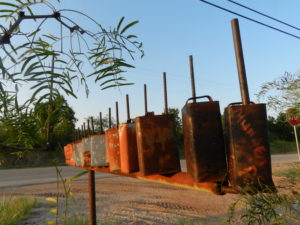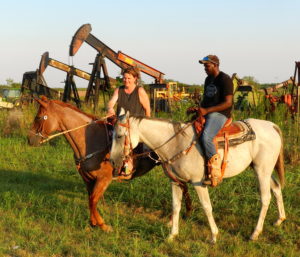The history of any 100-year-old oilfield can be told from various perspectives. Ginger Birdwell Beisch’s book about the KMA Field uses several, including her own voice.
 The idea to write the book came from her little brother, Michael Bruce Birdwell. He’s pictured at age four in the oilfield scene on the cover of the book. Also in the picture is his father, Johnny Birdwell, owner of Birdwell Well Service. Before his death in 2016, Michael Birdwell helped his sister gather information for her book. Naturally, she dedicated the book to him.
The idea to write the book came from her little brother, Michael Bruce Birdwell. He’s pictured at age four in the oilfield scene on the cover of the book. Also in the picture is his father, Johnny Birdwell, owner of Birdwell Well Service. Before his death in 2016, Michael Birdwell helped his sister gather information for her book. Naturally, she dedicated the book to him.
The title, KMA—Keeping Memories Alive, expresses Beisch’s primary reason for writing it—to keep memories of life in the oilfield from fading away even as the oil keeps flowing. The stories of many area families fill several pages. The story of her own family is typical.
Beisch’s paternal grandfather, Archibald Wherry Birdwell, was a cowboy. In the early 1900s, he and his wife, Cordia Mae, lived on ranches in the area. He died in 1920, the year after the discovery well came in. Widowed and living in Mankins, Cordia Birdwell made a living taking in washing and boarding oilfield hands. In 1947, her son Johnny Birdwell managed to buy a basic well service rig.
Beisch quotes him:
“There was no door on the truck—couldn’t take time to open and close it.”
Three decades later he was operating a fleet of five machines and had acquired some leases himself—rags to riches but not without plain old hard work from start to finish.
Life in oilfield housing is aptly described by Beisch and others who tell similar stories, one aspect being the gas provided via lines that tapped into the gathering lines from the wells. “The small amount used for cooking stoves and space heaters was not missed,” she said.
But the odorless gas could be dangerous if the gas quit flowing to a house and flames went out during the night. If the flow of gas resumed, occupants of a house with space heaters risked asphyxiation. “Most parents would not allow gas heaters to be allowed at night while sleeping,” Beisch wrote. “The family had to snuggle under blankets or quilts to stay warm.”
Beisch’s family enforced the rule even after switching to gas from the reliable Lone Star Gas Company.
The availability of casinghead gas was another free benefit to living in the oilfield, especially during World War II, when gas was rationed. Not that it was supposed to be utilized by anyone but oilfield workers, but unofficially it ended up serving many other people. Some casinghead gas, usually called “drip,” possibly even made its way to gas station operators who needed to stretch their wartime supply, Beisch wrote in a paragraph tucked into her chapter on the 1938 boom and the decade to follow and area churches and schools. In fact, one of her own school stories is about the time she and friends managed to acquire some drip gas when they were supposed to be on a different sort of errand. If they hadn’t smelled like gasoline when they returned to school, their little adventure would have gone unnoticed.
“It was obvious that we had taken a detour,” she wrote.
That chapter of Beisch’s book is a mixed bag. So are the other chapters. It’s an approach that enlivens the book with divergent topics. In fact, the very first chapter isn’t about oil at all. “Fossils, Buffalo, Indians, and Soldiers” sets the stage for developments to follow. By Chapter Three, things have changed. It’s “#1 Munger, Promoting, Gambling, and Murder.”
The book progresses chronologically, more or less. Chapter Five is “Depression (a reference to the economy), Deep Oil Search, Wet Gas, and Dry Holes.” But the tale of a treasure of buried silver that dates from the cowboys and Indians era is mentioned in a chapter dealing with the 1960s. That’s when a newspaper story drew new attention to the local legend. Beisch may once again capture the interest of treasure hunters besides those looking for black gold.
In the ending chapter, “Churches, Maps, Facts, and Figures,” is the six-month drilling log for the Munger No. 1 discovery well of 1919 and a 1938 article called “The Geology of KMA” from the KMA News, along with the texts from six historical markers in the area, including the marker for the Kadane Discovery Well, drilled in 1937.
Readers interested purely in the history of the oilfield may choose to ignore stories about other industries and various organizations. But anyone with ties to the area is likely to be looking for the name of a family member or colleague. Chances are they won’t be disappointed. Even schoolteachers are listed, not surprisingly since Beisch is herself a retired teacher.
In one sense, the book is perhaps her best teaching effort yet. It’s a lesson in history that captures the essence of life in an oilfield.
_________________________________________________
Freelance writer and photographer Hanaba Munn Welch maintains a website at www.hanaba.net.









